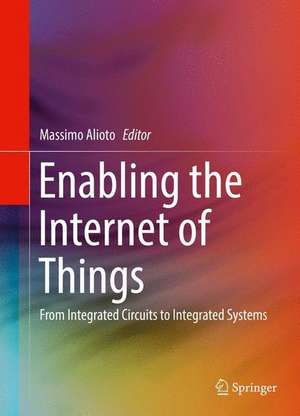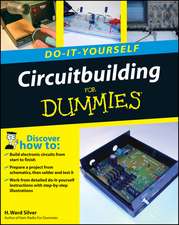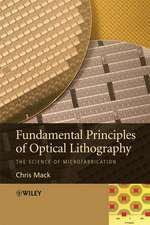Enabling the Internet of Things: From Integrated Circuits to Integrated Systems
Editat de Massimo Aliotoen Limba Engleză Hardback – 6 feb 2017
After providing a system perspective on IoT nodes, this book focuses on state-of-the-art design techniques for IoT applications, encompassing the fundamental sub-systems encountered in Systems on Chip for IoT:
- ultra-low power digital architectures and circuits
- low- and zero-leakage memories (including emerging technologies)
- circuits for hardware security and authentication
- System on Chip design methodologies
- on-chip power management and energy harvesting
- ultra-low power analog interfaces and analog-digital conversion
- short-range radios
- miniaturized battery technologies
- packaging and assembly of IoT integrated systems (on silicon and non-silicon substrates).
The unique balance between breadth and depth of this book:
- enables expert readers quickly to develop an understanding of the specific challenges and state-of-the-art solutions for IoT, as well as their evolution in the foreseeable future
- provides non-experts with a comprehensive introduction to integrated circuit design for IoT, and serves as an excellent starting point for further learning, thanks to the broad coverage of topics and selected references
- makes it very well suited for practicing engineers and scientists working in the hardware and chip design for IoT, and as textbook for senior undergraduate, graduate and postgraduate students ( familiar with analog and digital circuits).
| Toate formatele și edițiile | Preț | Express |
|---|---|---|
| Paperback (1) | 798.50 lei 6-8 săpt. | |
| Springer International Publishing – 18 iul 2018 | 798.50 lei 6-8 săpt. | |
| Hardback (1) | 1132.98 lei 6-8 săpt. | |
| Springer International Publishing – 6 feb 2017 | 1132.98 lei 6-8 săpt. |
Preț: 1132.98 lei
Preț vechi: 1381.68 lei
-18% Nou
Puncte Express: 1699
Preț estimativ în valută:
216.82€ • 235.44$ • 182.13£
216.82€ • 235.44$ • 182.13£
Carte tipărită la comandă
Livrare economică 22 aprilie-06 mai
Preluare comenzi: 021 569.72.76
Specificații
ISBN-13: 9783319514802
ISBN-10: 3319514806
Pagini: 520
Ilustrații: XIV, 520 p. 476 illus., 388 illus. in color.
Dimensiuni: 178 x 254 x 30 mm
Greutate: 1.14 kg
Ediția:1st ed. 2017
Editura: Springer International Publishing
Colecția Springer
Locul publicării:Cham, Switzerland
ISBN-10: 3319514806
Pagini: 520
Ilustrații: XIV, 520 p. 476 illus., 388 illus. in color.
Dimensiuni: 178 x 254 x 30 mm
Greutate: 1.14 kg
Ediția:1st ed. 2017
Editura: Springer International Publishing
Colecția Springer
Locul publicării:Cham, Switzerland
Cuprins
1. IoT: Bird’s Eye View, Megatrends and Perspectives.- 2. IoT Nodes: System-Level View .- 3. Ultra-Low-Power Digital Architectures for the Internet of Things.- 4. Near-Threshold Digital Circuits for Nearly-Minimum Energy Processing.- 5. Energy Efficient Volatile Memory Circuits for IoT Era.- 6. On-Chip Non-Volatile Memory for Ultra-Low Power Operation.- 7. On-Chip Non-Volatile STT-MRAM Memories for Zero-Standby Power.- 8. Security Down to the Hardware Level.- 9. Design Methodologies for IoT Systems on a Chip.- 10. Power Management Circuit Design for IoT Nodes.- 11. Energy Harvesting.- 12. Ultra-Low Power Analog Interfaces for IoT.- 13. Ultra-Low Power Analog-Digital Converters for IoT.- 14. Circuit Techniques for IoT-Enabling Short-Range ULP Radios.- 15. Battery Technologies for IoT.- 16. System Packaging And Assembly In IoT Nodes.- 17. An IPv6 Energy-Harvested WSN Demonstrator Compatible with Indoor Applications.- 18. Ferro-electric RAM Based Microcontrollers: Ultra-Low Power Intelligence for the Internet of Things.
Recenzii
“The book itself comprises a lengthy and well-written introduction to IoT, followed by several chapters giving guidance with respect to design details and methodologies. … this work provides useful insight into the field. Each chapter is well illustrated and well referenced.” (Computing Reviews, August, 2017)
Notă biografică
Massimo Alioto took the M.Sc. and the Ph.D. degree in 1997 and 2001 from the University of Catania (Italy). He is currently with the ECE department of the National University of Singapore, where he leads the Integrated Circuits and Embedded Systems area. Previously, he held positions at the University of Siena (2002), EPFL (summer of 2007), University of California at Berkeley (2009-2011), University of Michigan Ann Arbor (2011-2012), and Intel Labs in Oregon (2013). He has authored more than 220 publications and three books, and has delivered 50+ invited talks in top universities, semiconductor companies and conferences in the last five years. He was IEEE Distinguished Lecturer, Chair of the “VLSI Systems and Applications” CASS Technical Committee, and Associate Editor in Chief of the IEEE Transactions on VLSI Systems. He has served as Guest Editor of several journal special issues (e.g., TCAS-I, TCAS-II), Associate Editor of a number of IEEE/ACM journals (e.g., TCAS-I, TVLSI, TODAES,TCAS-II), and Technical Program Chair in several IEEE conferences (e.g., SOCC, ICECS, NEWCAS, VARI, ICM, PRIME). Prof. Alioto is an IEEE Fellow.
Textul de pe ultima copertă
This book offers the first comprehensive view on integrated circuit and system design for the Internet of Things (IoT), and in particular for the tiny nodes at its edge. The authors provide a fresh perspective on how the IoT will evolve based on recent and foreseeable trends in the semiconductor industry, highlighting the key challenges, as well as the opportunities for circuit and system innovation to address them. This book describes what the IoT really means from the design point of view, and how the constraints imposed by applications translate into integrated circuit requirements and design guidelines. Chapter contributions equally come from industry and academia.
After providing a system perspective on IoT nodes, this book focuses on state-of-the-art design techniques for IoT applications, encompassing the fundamental sub-systems encountered in Systems on Chip for IoT:
The unique balance between breadth and depth of this book:
After providing a system perspective on IoT nodes, this book focuses on state-of-the-art design techniques for IoT applications, encompassing the fundamental sub-systems encountered in Systems on Chip for IoT:
- ultra-low power digital architectures and circuits
- low- and zero-leakage memories (including emerging technologies)
- circuits for hardware security and authentication
- System on Chip design methodologies
- on-chip power management and energy harvesting
- ultra-low power analog interfaces and analog-digital conversion
- short-range radios
- miniaturized battery technologies
- packaging and assembly of IoT integrated systems (on silicon and non-silicon substrates).
The unique balance between breadth and depth of this book:
- enables expert readers quickly to develop an understanding of the specific challenges and state-of-the-art solutions for IoT, as well as their evolution in the foreseeable future
- provides non-experts with a comprehensive introduction to integrated circuit design for IoT, and serves as an excellent starting point for further learning, thanks to the broad coverage of topics and selected references
- makes it very well suited for practicing engineers and scientists working in the hardware and chip design for IoT, and as textbook for senior undergraduate, graduate and postgraduate students ( familiar with analog and digital circuits).
Caracteristici
Covers all the fundamental building blocks and levels of abstraction related to the design of IoT devices, from circuit to architectures and systems Addresses the design of IoT nodes and related promising solutions in a cohesive manner, maintaining a constant focus on the "big picture" Presents innovative design techniques and motivates them consistently through a clear, system-level perspective and the consequences of actual constraints in IoT devices. Includes supplementary material: sn.pub/extras










